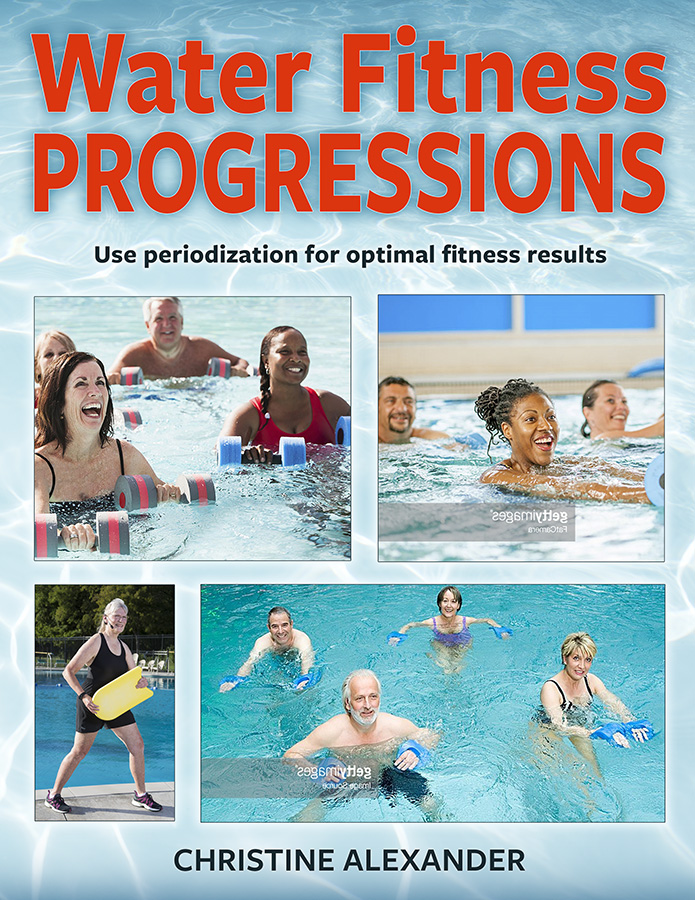
The way to make your heart stronger is to make it beat faster. Since there is a direct correlation between how fast your heart is beating and how fast you are breathing, making your heart stronger means exercising at a pace that makes you breathe faster than normal. Interval training is a popular way to meet this objective.
Interval training is alternating bouts of fast paced exercise with slower paced exercise. The fast pace is called work and the slower pace is called recovery. One period of work plus one period of recovery is called a set. A group of sets is called a cycle. The chart above shows a cycle of five sets of intervals. If you are jogging, your work might be running and your recovery could be walking. In a water exercise class, your work might be performing an exercise faster, but there are other ways to increase intensity.
The basic aquatic exercises of jog, kick, cross-country ski and jumping jacks can all be performed at a somewhat easy level. Your breath will be faster than standing still, but you can still do the exercises while talking or even singing. To increase the intensity to a moderate level, increase the range of motion, that is, make the moves larger. Your breath will be a little faster and although you will still be able to talk, it will be harder to sing. To increase the intensity to a somewhat hard level, increase the speed of the exercise. Try not to lose range of motion as you go faster. For many people, taking the exercise to a suspended position is also somewhat hard. With faster moves or suspended moves you may be able to talk, but you will be breathing hard enough that you won’t really want to talk. To work at a hard level, add acceleration. This could be by jumping but you can also perform the exercise with power. The harder you push against the water the harder the water pushes back. Power moves are slower but the effort is greater. At this level, you might be able to grunt in response to a question and you will feel like you can only keep that pace for a short time.
Click on this linkhttps://youtu.be/g5V0lzwTi40 to watch a video of the basic exercise of cross-country ski in shallow water along with the variations of increasing range of motion, increasing speed, going suspended, adding power, and adding rotation (a variation of a power move). Each variation is performed for 4 counts.
Click on this link https://youtu.be/ZDJnhaxP5cU to watch a video of the basic exercise of cross-country ski in deep water along with the variations of increasing range of motion, increasing speed, adding elevation (accelerating the legs toward center to lift the shoulders out of the water), adding power and adding rotation. Each variation is performed for 4 counts.
The work period and the recovery period of an interval can last for a few seconds up to a few minutes. Usually the recovery period is longer than the work period so that you can recover fully before starting the next work period, but you can have a reduced recovery period for an added challenge. Some ways to time the intervals are:
- Interval 30: 30 seconds of work to 90, 60 or 30 seconds of recovery
- Interval 40: 40 seconds of work to 80, 60 or 40 seconds of recovery
- Interval 60: 60 seconds of work to 120, 90 or 60 seconds of recovery
- Reduced Recovery Time: 1, 2 or 3 minutes of work to 30, 60 or 90 seconds of recovery
- Rolling Intervals: work for 1 minute, increase intensity for 1 minute, and increase intensity again for another minute
- Surges: work for 45 seconds and increase intensity for 15 seconds to 60 seconds of recovery
- Tabata – 20 seconds of work to 10 seconds of recovery 8 times

These ways to time intervals, plus additional timing options, are explained in my book, Water Fitness Progressions. The book also includes sample lesson plans that use these timing options with variations for moderate, somewhat hard or hard intensities. To order the book from the publisher, click on the title. The book can also be ordered from Amazon.com
See you in the pool!


Hello! I wish to say that this post is awesome, well written and with important
info. I’d like to see more posts like this!
🙂